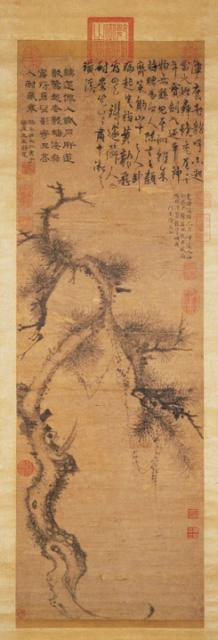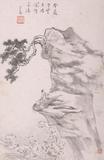元楊維禎歲寒圖 軸
推薦分享
資源連結
連結到原始資料 (您即將開啟新視窗離開本站)後設資料
- 資料識別:
- 故畫000305N000000000
- 資料類型:
- 類型:繪畫
- 型式:靜態圖像
- 著作者:
- 楊維禎
- 主題與關鍵字:
- 松
- 出版者:
- 數位化執行單位:國立故宮博物院
- 格式:
- 本幅 98.1x32公分、全幅 51.4公分
- 關聯:
- 故宮書畫錄(卷五),第三冊,頁228&*石渠寶笈初編(御書房),下冊,頁1117 &*故宮書畫圖錄,第四冊,頁265-266&*楊維禎(西元一二九六—一三七0),字廉夫,號鐵崖,後因善吹鐵笛,遂自號鐵笛道人,又曰抱遺老人,浙江會稽人。元泰定間署天台尹,又曾會修遼金宋三史。入明,徙居松江。能文善詩,詩文俊逸,獨擅一時,稱為鐵笛體,書畫兼善。 此幅畫松一株,蟠榦夭矯,枝葉秀出,極得清勁之氣。又自題詩句鏗鏘,書法遒秀,堪稱三絕。&*Yang Wei-chen (style name; Lien-fu, sobriquets; T'ieh-yai and Pao-i lao-jen), was a native of K’uai-chi, Chekiang. Since he was a skilled player of the t'ieh-ti (iron flute), late in life he also called himself T'ieh-ti lao-jen. He held a government post in T'ien-t'ai, Chekiang, during the T'ai-ting era (1324-1328) and was also involved in the compilation of the official histories of the Sung (960-1279), Liao (907-1125), and Chin (1115-1234) dynasties. When the Ming dynasty was established in 1368, he moved to Sung-chiang, Kiangsu. The bold and original style of his literary talent was special and became known as the "T'ieh-ti style." He was also a good painter and calligrapher. In this work he has painted a serpentine branch of pine, the twigs and needles of which poke outwards. It is a perfect image of unsullied strength. The artist's poem also has a fine ring and he has written it out with forceful elegance. Such a work both exemplifies and unifies the arts of poetry, calligraphy, and painting.
- 管理權:
- 國立故宮博物院
授權聯絡窗口
- 國立故宮博物院圖像授權、出版授權、影音資料授權-申請流程說明
http://www.npm.gov.tw/zh-TW/Article.aspx?sNo=03003061






